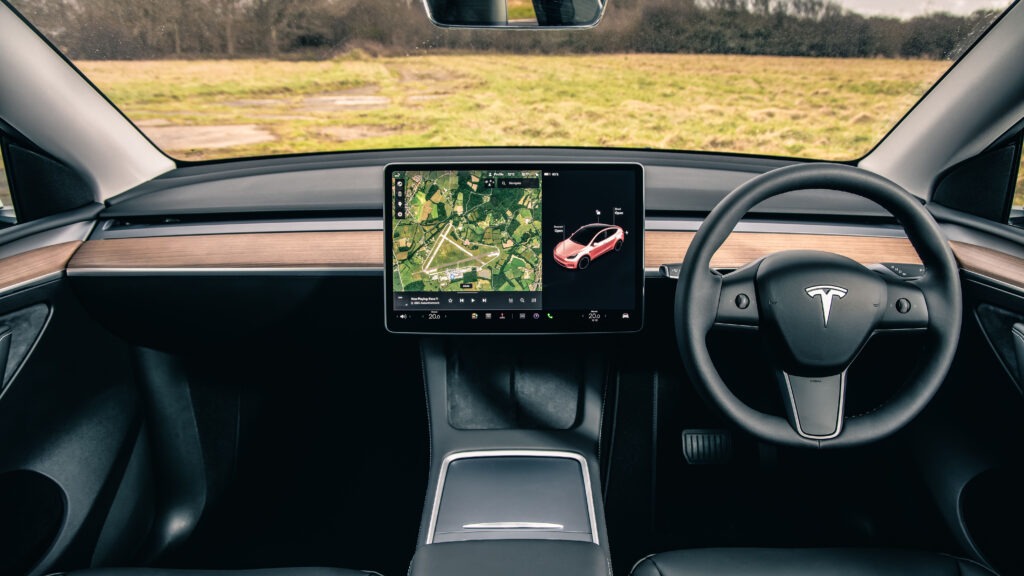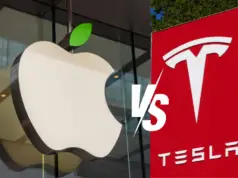Are you frustrated because your Tesla microphone isn’t working?
You’re not alone.
It’s a common problem that many Tesla owners face.
When the microphone malfunctions, it can make driving a stressful and potentially dangerous experience.
The good news is that there are steps you can take to fix this issue.
How to Fix Tesla Microphone Not Working Issue?

#1. You May Need to Re-Pair Your Phone with Tesla
One of the possible reasons why your Tesla Bluetooth microphone is not working is that it is not paired with your phone.
You can check and change the pairing status of your mic through the Tesla touchscreen. Sometimes, your mic may disconnect due to various factors, such as software updates, interference, or low battery.
Pairing your device with your Tesla vehicle allows you to use the Bluetooth microphone for hands-free calling, voice commands, and media streaming.
You can pair up to two devices at a time, such as a phone and a controller, or designate one device as the priority device.
To pair your device with your Tesla vehicle, you need to follow these steps:
Fix – Re-Pair your phone with your Tesla
1. Turn on both the Tesla touchscreen and your phone.
2. Enable the discoverable mode on your phone. Depending on your phone model, you may have to stay in the Bluetooth settings for this process.
3. Select the Bluetooth icon on the Tesla touchscreen from the Controls screen.
4. Select Add New Device
5. Select Start Search. Your device, and other devices that are in discoverable mode, will show up in a list.
6. Pick your desired device from the list.
7. Follow the instructions to enter the numbers for pairing and verify that you enter them correctly.
8. If your phone prompts you, choose whether you want to let Model S access your personal information, such as calendar, contacts, and media files (see Importing Contacts and Recent Calls).
9. When paired, Model S automatically connects, and the Bluetooth settings screen displays the Bluetooth symbol next to the device name to indicate that the connection is active.
10. Test your Tesla Bluetooth microphone by making a call or using a voice command.
Note: Model S can only support up to two Bluetooth devices at a time (such as two controllers or one phone and one controller).
#2. Cache Clearing Required
Sometimes, the cache and data history of the Tesla infotainment system may get corrupted or outdated, causing the microphone to malfunction.
The cache and data history store information such as Bluetooth pairing, voice feedback, and volume settings. Clearing the cache and data history can help to reset these settings and fix the microphone issue.
How to Clear the Cache and Data History?
To clear the cache and data history of the Tesla infotainment system, you need to follow these steps:
- Go to your Tesla’s infotainment system
- Select controls
- Now select Safety & Security
- Scroll until you see the Clear Personal Data option and select it
- Select Clear the Cache and Data Related to Bluetooth
- Now you will need to restart your Tesla and reconfigure your Bluetooth connection.
- Test your Tesla Bluetooth Microphone
#3. Your Bluetooth Microphone May Be Turned Off or Disabled
1. You can access the Bluetooth settings screen at any time and adjust the settings related to a connected device.
For example, you can set a connected phone as the Priority Device.
This is useful when you have connected more than one phone, and both phones are often used in Model S at the same time.
2. Model S automatically tries to connect to the priority device before others.
If no priority device is specified or is out of range, Model S connects to the most recent phone (if applicable)
3. Sometimes, you may accidentally turn off or mute the Bluetooth microphone on your Tesla touchscreen or your phone.
This can prevent you from using the microphone for calls or voice commands.
Fix – Check the Bluetooth Microphone settings
1. Go to your menu and navigate to the Settings menu on your Tesla touchscreen.
2. Choose the audio or the sound setting. Either or both the audio and sound settings will let you see the Bluetooth microphone status.
3. Next, make sure that the microphone is enabled on the sound and/or the audio screen.
There is a chance that you may have accidentally switched off the microphone, causing you to have microphone-related problems.
4. Also, check if the microphone is muted on your phone or on the Tesla touchscreen. You can unmute it by tapping on the microphone icon on either device.
Note: If you have the option to change the microphone sensitivity on your Tesla model, you should check that you have the sensitivity settings set to a level where it’s not too high or too low.
Finding the right balance could prevent future issues with your Tesla Bluetooth Microphone connectivity.
#4. There are Physical Connection Issues
1. Sometimes, we ignore the physical aspects of the problem because we are focused on the technical aspects of electronics.
Secure connections are essential for reliable Bluetooth microphone functionality.
2. The Bluetooth microphone on your Tesla vehicle is located near the rearview mirror on the windshield.
It is connected to a wire that runs through the headliner and down to a port behind the glove box.
If there is any damage or loose connection in this wire or port, it can affect the microphone performance.
Fix – Check the physical connection of the Bluetooth Microphone.
1. Examine the connection ports inside your Tesla vehicle and make sure that they are connected properly.
2. Go to your Tesla infotainment system. Find the microphone port behind the glove box.
3. Look for loose connections, and fix them if you find any.
4. Look for debris in ports that are not connected. Clean with compressed air, a soft clean brush, or a cotton swab to remove any dirt or dust that may be interfering with the connection.
5. Test your Tesla Bluetooth microphone again by making a call or using a voice command. Note: If you notice any damage to the ports or the wires, you should contact Tesla service for assistance.
#5. Time to Reboot Your Infotainment System
1. Sometimes, a simple reset of the Tesla touchscreen can fix many issues, including the Bluetooth microphone problem.
A reset can clear any glitches or bugs that may be affecting the performance of the touchscreen or the microphone.
2. There are two types of resets you can perform on your Tesla touchscreen: a soft reset and a hard reset.
A soft reset is like rebooting your computer, while a hard reset is like disconnecting the power source.
A soft reset is usually enough to solve most problems, but a hard reset may be needed if the soft reset does not work.
Fix – Reset your Tesla touchscreen
1. To perform a soft reset, press and hold both scroll buttons on the steering wheel until the touchscreen turns off and then back on. This may take up to 10 seconds.
2. To perform a hard reset, press and hold both scroll buttons and the brake pedal until the touchscreen turns off and then back on. This may take up to 20 seconds.
3. After the reset, check if your Tesla Bluetooth microphone is working properly by making a call or using a voice command.
#6. Software Glitching Causing the Microphone Issue
1. Another possible reason why your Tesla Bluetooth microphone is not working is that your Tesla software is outdated or corrupted.
Tesla software updates can improve the functionality and performance of your vehicle, including the Bluetooth microphone.
2. You can check if there are any available updates for your Tesla software through the touchscreen or the Tesla app on your phone.
You can also schedule updates to be installed at a convenient time for you.
Fix – Update Tesla software
1. To check for updates on the touchscreen, tap Controls > Software. If an update is available, you will see a yellow clock icon next to the Software tab.
Tap it to view the details and options for the update.
2. To check for updates on the Tesla app, open the app and tap Controls > Software Update. If an update is available, you will see a notification on your phone.
Tap it to view the details and options for the update.
3. To install an update, you need to have at least 20% battery charge and be connected to a Wi-Fi network or a cellular network (depending on your region and vehicle model).
You also need to ensure that your vehicle is parked and not in use during the update process.
4. You can choose to install the update immediately or schedule it for later.
The update may take up to an hour to complete, depending on the size and content of the update. You will receive a notification when the update is done.
5. After the update, verify if your Tesla Bluetooth microphone is working correctly by making a call or using a voice command.
#7. Factory Reset Your Tesla
A factory reset is a drastic measure that should only be done as a last resort. It will erase all your personal data and settings, and you will have to reconfigure everything from scratch
To do this, go to your Tesla’s infotainment system and select Controls.
Then, select Safety & Security and scroll until you see the Factory Reset option.
Sign in to your Tesla account using your email address and password and tap Continue. The factory reset will start and may take several minutes to complete.
Note: Before you perform a factory reset on your Tesla, make sure you back up any important data or settings that you want to keep.
You may also need to reconfigure your Bluetooth connection, Wi-Fi network, driver profile, and other preferences after the reset.
Why is the Tesla Microphone not working?
Before delving into the solutions, it’s essential to understand the root cause of the problem. The issue could be due to a software glitch, physical obstruction, or a faulty microphone.
Whatever the cause may be, it’s essential to address the problem as soon as possible to ensure your safety on the road.
#1. Your phone or Bluetooth may not be compatible with your Tesla software
If you’re using a phone not listed as compatible with your Tesla’s software, it may be because of an incompatibility between the two devices. This can cause issues with the Bluetooth connection and the microphone function.
To fix this, you can try to update your phone’s software or switch to a compatible phone.
#2. Your phone may not have enough memory space to store the Bluetooth information
If you’re using a USB cable to connect your phone to your car, it may not be a Tesla-approved one. This can cause interference or damage to the Bluetooth connection and the microphone function.
If your phone has low storage space, it may not be able to store the necessary information for the Bluetooth connection with your car. This can affect the quality and stability of the connection and the microphone function.
To fix this, you can try to free up some space on your phone by deleting unnecessary files or apps.
#3. You may be using a non-Tesla-approved USB cable to sync with your phone
To fix this, you can try to use a Tesla-approved USB cable or switch to a wireless connection.
#4. Your microphone may be blocked by dirt or objects
If your microphone is blocked by dirt or objects, it may not be able to pick up your voice clearly or at all. This can affect voice commands, phone calls, and other functions that rely on the microphone.
To fix this, you can try to clean the microphone or remove any objects that may be blocking it. The microphone is located in the overhead console near the front camera.
#5. Your car or phone may need a reboot
Sometimes, a simple reboot can solve many software issues that may affect the Bluetooth connection and microphone function. To reboot your car, you can press and hold both scroll buttons on the steering wheel until the touchscreen turns black.
To reboot your phone, you can turn it off and on again. This can help to refresh the Bluetooth connection and clear any glitches.
#6. You may need to unpair and pair your phone again
If rebooting does not work, you may need to unpair and pair your phone again with your car. This can help to reset the Bluetooth connection and fix any issues that may have occurred.
To do this, go to Settings > Bluetooth > Devices on your car’s touchscreen and tap on your phone’s name. Then tap on Forget Device. On your phone, go to Settings > Bluetooth and tap on your car’s name.
Then tap on Forget This Device. After that, pair your phone again with your car by following the instructions on the screen.
#7. You may need to reset the MCU (Media Control Unit) of your car
If none of the above methods work, you may need to reset the MCU of your car. This is a more drastic step that can erase some of your settings and preferences, so make sure to back them up before proceeding.
To reset the MCU, press and hold both scroll buttons and both brake pedals simultaneously until the touchscreen turns black. Wait for a few minutes until the touchscreen reboots.
Additional Ways To Troubleshoot Tesla Microphone Not Working Problem
Method #1: Check Your Microphone Settings
The first thing you should do is make sure that your microphone is enabled and has access to your device. To do this, you need to go to the Settings app on your Tesla touchscreen and select Privacy.
Then, choose Microphone and click on the Change button under Allow access to the microphone on this device.
Method #2: Reboot your Tesla
Sometimes, a simple reboot can solve many issues with your Tesla.
1. Please park the vehicle and shut all the doors.
2. Then, press and hold the car’s brake pedal and the two scroll wheels on the steering until the main screen goes off.
3. Release the brake pedal and scroll buttons when the screen comes back on.
Alternatively, you can use the method below.
Method #3: Full Vehicle Reset or Power Cycling
1. Park the Tesla in a safe place and shut all the doors.
2. Take your foot off the brake pedal to relieve it.
3. Access the car’s main screen.
4. Navigate to controls, then open ‘safety and security.’
5. Next, select the power off option.
6. The screens, interior light, and system will shut down.
7. Wait for at least five minutes until everything in the car is quiet.
8. Avoid touching anything inside the car while waiting.
9. After five minutes, press the brake pedal or open the car’s door to reawaken the Tesla.
10. The sound would generally restart after this.
Method #4: Unpair and pair your phone again
If you are having trouble with your Bluetooth phone calls, you may need to unpair and pair your phone again with your Tesla.
To do this, you need to go to the Bluetooth settings on your Tesla touchscreen and select your phone.
Then, click on Forget Device and confirm.
Next, go to the Bluetooth settings on your phone and forget your Tesla. Finally, pair your phone again with your Tesla by following the instructions on the screen.
Contact Tesla support
If none of the above steps work, you may have a hardware issue with your microphone or a software bug that needs to be fixed by Tesla.
You can contact Tesla support by calling them or scheduling a service appointment through the Tesla app.
You can also report the issue through voice recordings by saying “Note” or “Report” followed by a brief description of the problem.
I hope this article helps you with your Tesla microphone issue. If you have any feedback or suggestions, please let me know.





